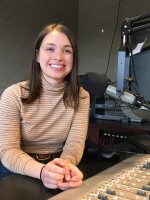The Park City Traffic Control Center has been up and running since the end of December. How does it work, and will it make getting around town easier during peak traffic times? KPCW’s Emily Means has this.
A wall of monitors shows video of a car backing into an intersection on state route 224, after turning into the wrong lane in the snow. On the next wall over, a “flow map” illustrates in red where traffic has slowed down on Interstate-80, interpreting information tracked by speed sensors along major highways.
Park City Municipal paid $80,000 to provide staff, equipment and furniture for the Traffic Control Center. The installation took a couple of months, after six months of planning and design. Transportation Planning Manager Alfred Knotts helmed the project. He says the old way of communicating traffic events to affected parties—texting, calling after an accident has happened—made it difficult to be proactive in those situations.
"We’ve always talked about not building our way out of congestion, and infrastructure projects cost millions of dollars per mile," Knotts said. "I think when you look at this $80,000 price tag, when we can get more throughput through the system, more response time, better traveler information—that’s a very cost-effective way of increasing capacity within your transportation system. It’s known as an intelligent transportation system, and ITS systems are around the whole country. UDOT uses a lot of ITS technology, so we just wanted to tap into that system and get better use out of it."
The Control Center is set up in a formerly unutilized office at the Park City Police Department, which was one way to cut costs for the project. The space provides a central location for the police, the Park City emergency manager and the Transportation Department to communicate with each other as well as the Utah Department of Transportation, Utah Highway Patrol and Summit County. Captain Phil Kirk with the Park City Police views it as a tool to anticipate traffic problems before they evolve into something difficult to manage.
"We use it as kind of an early warning device, so Alfred's people in the traffic operations center can alert us to problem areas before they become critical mass, where traffic is shut down completely," Kirk said. "So when we hear from him as he’s monitoring this, or as his people are monitoring this, if we hear that there are some issues out there in traffic, then we’ll go check those with our officers and try to do the best we can to address that before it becomes a serious traffic issue. I think this really helps us get to those problem areas much quicker, otherwise we’re going to have to wait maybe until somebody calls in or there’s an accident."
Knotts says that the data collected from the Control Center will aid in future transportation projects and traffic management for the city. He says data has already been collected to predict traffic congestion, but watching bottlenecks happen in real time validates the models.
"It helps us get average daily traffic volumes, looking at what those peak times are, both in the near term and also in the long term," Knotts said. "If you look at the screen in the background there in front of Squatters, that left-hand turning movement off of 224 to 248—that’s not something that’s really been identified as a critical congestion point or choke point. However, through our 248 traffic modeling we have identified that that queue and that delay will continue to be exasperated over the foreseeable future, unless we do something in that area."
The Control Center will be put to the test in the next few weeks, with the Sundance Film Festival and the FIS World Championships bringing extra visitors to town. But on travelers’ parts, Knotts suggests consolidating trips, carpooling or taking transit to reduce traffic.




